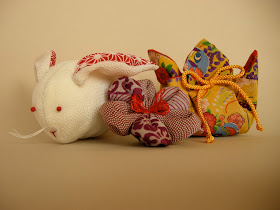It is time to prepare for Hina Matsuri, the Doll Festival, celebrated by families with daughters. I have written about it on the Hina page (found at the top of this blog, or click here).
Traditionally you display the dolls from about a month before March 3rd, which is the main day. The best time to put up the decorations is on a TAIAN (大安), a lucky day, according to the Chinese calendar. Today is Taian:
Many families have a set of the traditional dolls, the Imperial Couple and their attendants in ancient dress. You can read about them here.
Families with less space might have other decorations, like these made of paper, Japanese lacquer, clay or porcelain.
I, on the other hand, continue to stick to my favourite type of ornament, the Hanging Hina Dolls. Making stuffed dolls and ornaments from kimono scraps is an old tradition in mainly three areas of Japan: Inatori a hot spa town on the Izu Peninsula, Yanagawa in Fukuoka, Kyushu, where the dolls are hung across the river and the best way to enjoy this festival is of course from a boat on the river and Sakata in Yamagata Prefecture where the dolls are dangling from Japanese paper umbrellas. Click on the links and enjoy!
So I spent yesterday making three new ornaments for my own display; a Rabbit, a Flower and a Bag of Fortune:
Tomorrow I'll post a tutorial for the rabbit.




what a lovely tradition Queenie, you have lots of interesting things hanging from your decoration. The 3 new additions look great too, will pop over and read all about it in your links now
ReplyDelete'Girls' never grow up in Japan! You can find old ladies who still display their dolls, every year, cook the traditional dishes and feel 'young' on March 3rd. I think it is lovely to continue to celebrate in spite of one's age.
DeleteThe three areas where the hanging Hina dolls originated are now popular tourist spots and there is a whole business built around it. Coach tours are arranged there, special menus are served in the restaurants and many souvenirs are sold.
I have a lovely book by Kimodo Sudo called Omiyage and it full of wonderful little gifts to make like the ones you have posted. I bought a whole lot of Chimera fabric in a department store in Tokyo when I accompanied a school excursion about 10 years ago. Problem is the fabric is so lovely I had to cut into it.
ReplyDeleteKumiko Sudo's books are full of charming projects. It is interesting with people who move abroad and develop a new twist their country's old traditions. Ms Sudo has given origami a totally new twist; I am now referring to her book Fabled Flowers which folded fabric appliqué.
DeleteWell, fabric SHOULD be used, no...?
So nice to see old traditions time to reflect and move on. Such beautiful fabrics the colours are so bright and vibrant, cheers up this grey day.
ReplyDeleteYes, traditions are important to feel one's own place in history. Many families here in Japan have dolls that have been handed down for generations, and the real old dolls have a special patina. It is also nice with a tradition that is creative and lets you make your own mark.
DeleteLook forward to your tutorial on the rabbit, they really interesting .
ReplyDeleteTill tomorrow .
Hi! I must be a little girl at heart because I LOVE the Hina festival and really enjoy making a few new pieces each year. The rabbit was quite easy.
DeleteWhat a lovely and sweet tradition: I am going to read about it :)
ReplyDeleteYour decoration is just charming and give light to our grey days.
I wish you a great week,
Isa
I'm glad if I can share some of the sunny Tokyo weather!
DeleteIt is always a pleasure for me to read your interesting posts and to see your great works!Thank you so much!
ReplyDeleteI can hardly believe that I should explain a stitch to you. If so, is it the filler stitch? I will show it in my next post. Is a honour for me!
Oh, PLEASE do!
DeleteYou are lucky Queenie to have a nice weather in Tokyô and yes, thanks again to share your sun with us :))
ReplyDeleteWhat a lovely tradition! I like your new additions. Just read the info in the links, luckily I could set the Wiki on Dutch, much easier to read for me! Some if it I already knew from my origami days, I think I folded some imperial dolls at the time.
ReplyDeleteYes, isn't it nice when one can read an article in one's own language! There is indeed an origami pattern for the Imperial couple.
Deletethank you for sharing information about this Japanese Custom. it is very intereting. I still known the traditional representation of the imperial familie, but I like the picture where you showed modern representation.
ReplyDeleteThere are so many ways to make Hina dolls, e.g. by folding paper art, origami, that Annet mentioned. I have also seen dolls made by nursery school children out of kitchen paper rolls. Now there is a knitting/crochetting boom I guess there will be knitted dolls as well!
Delete